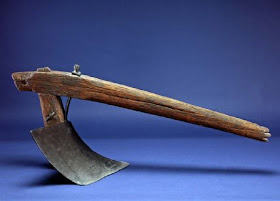To start off our list,
#1, George Washington:
 |
| Our nation's first president also had the nation's largest Whiskey Distillery of the time. |
 |
| Washington at Mt. Vernon (painting by Stearns) |
 |
| Are these guys related to Washington's stud Royal Gift? |
#2, John Adams:
 |
| A humble man and the father of of a president! |
"Let me have my farm, family and goose quill, and all the honors and offices this world has to bestow may go to those who deserve them better and desire them more. I count them not."
#3, Thomas Jefferson:
Our third president was possibly our most agriculturally involved president. Jefferson was zealous about soil conservation, wrote books on farming, maintained a large plantation at Monticello and even won a Gold Medal from the French Society of Agriculture in 1809.
 |
| Jefferson was what might be considered, a true Renaissance Man. |
 |
| Monticello Gardens |
"Agriculture is our wisest pursuit, because it will in the end contribute most to real wealth, good morals and happiness."
#4, James Madison
 |
| Madison |
#5, James Monroe:
A few very important things happened during the presidency of James Monroe that affected agriculture.
First and foremost, the Land Act of 1820 allowed farmers to purchase up to 85 acres of land at only $1.25 an acre. 3.5 MILLION acres in new Western territories were purchased in 1820 alone.
 |
| Ohio under the Land Grant of 1820 |
Also during this time, farming became more a commercial trade. With the beginning of industrialization and the advent of more efficient farming practices, people could move to town and those remaining in rural areas could grow more crops and raise more livestock to sell for profit to those in town. People no longer had to grow their own food to sustain themselves.
#6, John Quincy Adams:
 |
| J.Q. Adams was actually the son of President #2, John Adams! |
 |
| The Erie Canal, c. 1825 |
With the completion of the Erie Canal (and subsequently, the Ohio-Erie Canal) in 1825, transportation of agricultural goods across inlands became much more practical.
 |
| Ohio' s canal routes |
#7, Andrew Jackson:
"Agriculture, the first and most important occupation of man, has compensated the labors of the husband man with plentiful crops of all the varied products of our extensive country."
Andrew Jackson's plantation, the Hermitage, actually remains as part of working farm today, in addition to being a historical site.
Check out how agriculture works at the Hermitage today!
#8, Martin Van Buren:
While he may not have been one of our most memorable presidents (really, who thinks about Martin Van Buren?), but during his presidency, agriculture accounted for 73% of America's total exports and brought $74 million to the economy. So go Martin!
.jpeg) |
| A forgettable president, but a memorable industry. |
 |
| Ze steel plow of John Deere! |
#9, William Henry Harrison:
It's quite difficult to find information about a guy who was only in office 40 days. That's what happens when you give a 90 minute inaugural speech in the cold March rain. But hey, he was the first president from Ohio, the first president to die in office and of special importance to this list, the first president OF THE HAMILTON COUNTY AGRICULTURAL SOCIETY! Harrison helped found the Ohio county's ag society and yearly fair in 1819.
 |
| Paving the way for Ohio presidents since 1840... |
And #10, John Tyler:
Today's inaugural post on the president's and agriculture (see what I did there?) concludes with our 10th chief of state, John Tyler.
John promoted agriculture and commerce, calling them "twins" and mandated that they should not be "restricted by the folly of high duties and tariff restrictions." Tyler definitely championed America as a leading exporter of agricultural products. He once said that "America is the granary of the world."and indeed it still is to this day.
Stay tuned for tomorrow's installment of The Forty-Four Presidents and Farming, featuring heads of state #11-20!
P.S. Sorry this is practically tomorrow anyways. Tomorrow's will be up before 11 pm, I promise!





No comments:
Post a Comment